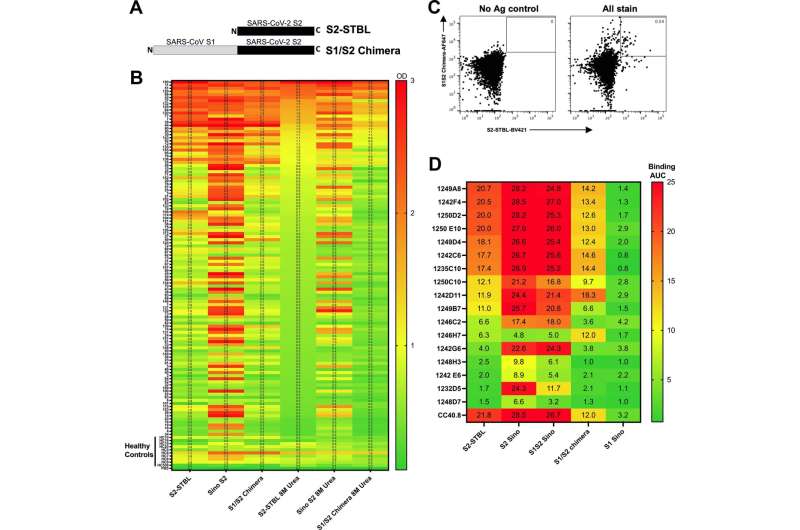
The SARS-CoV-2 that causes COVID-19 has killed 6.3 million people worldwide since 2019, painfully highlighting the vulnerability of humanity to novel coronaviruses.
Researchers discovered a neutralizing monoclonal antibody that potentially acts as a potent universal coronavirus therapy against SARS-CoV-2 and all its variants of concern, including beta, gamma, delta, epsilon and omicron. It also shows effectiveness against the deadly previous coronaviruses SARS-CoV, the Severe Acute Respiratory Syndrome that emerged in China in 2002, and MERS-CoV, the Middle East Respiratory Syndrome that appeared in Saudi Arabia in 2012. It even shows effectiveness against several common cold coronaviruses.
This universal activity against all beta-coronaviruses results from a monoclonal antibody targeting the S2 stalk region of the viral spike (S) protein that is highly conserved among beta-coronaviruses, yet is also essential for the virus to attach and enter cells, leading to infection.
In animal experiments, the monoclonal antibody protected against infections when given as an intraperitoneal injection or a nasal dose. The study is published in the journal PLOS Pathogens by co-senior authors James J. Kobie, Ph.D., and Mark R. Walter, Ph.D., of the University of Alabama at Birmingham, and Luis Martinez-Sobrido, Ph.D., of the Texas Biomedical Research Institute, San Antonio, Texas.
The monoclonal antibody, and another monoclonal antibody discovered earlier by the researchers, are being developed as a therapeutic cocktail for COVID-19 under license to Aridis Pharmaceuticals, a California biopharmaceutical company.
The overall goal of researchers at UAB, Texas Biomedical Research Institute and Aridis is to find antibodies that do not permit immune escape by mutated variants of SARS-CoV-2, the virus that causes COVID-19. This includes omicron and any future variants of concern. It is hoped that identifying and studying such antibodies can lead to the development of vaccines that protect from all coronaviruses.
“SARS-CoV-2 marks the third time in the last two decades a beta-coronavirus has caused significant mortality in humans,” Kobie said. “SARS-CoV-2 has caused the most infections and deaths worldwide. New variants pose the risk of evading the immune system—even in vaccinated and previously infected individuals—and there remains the potential for other genetically distinct coronaviruses to emerge as new pandemic strains in the future.”
“For these reasons, finding new therapeutic and prophylactic drugs and vaccine strategies that have universal activity against the coronavirus is essential for protecting humanity against the current and future beta-coronavirus outbreaks or pandemics.”
Vaccines and other monoclonal antibodies against SARS-CoV-2 have largely focused on the receptor-binding domain, or the RBD, located at the heads of the S viral protein spike that projects from the surface of the virus. Each virus has 24 to 40 spikes. The RBD is very good at eliciting an immune response, but that portion of the S permits many mutations that can let the virus escape antibodies.
One key in the present research was finding an antibody target on a part of the spike called the S2, or the stalk region. This region is highly conserved and only rarely mutates because that would disrupt its essential function. After the RBD at the head of the S attaches the coronavirus to a receptor molecule on the surface of a target cell, the S2 stalk acts to bring the virus inside the target cell. There the virus replicates, killing the cell and releasing a hoard of new, infectious virions.
The hunt for useful antibodies began with screening blood samples from adult convalescent patients at UAB Hospital through the UAB COVID Enterprise Biorepository led by Paul Goepfert, M.D., and Nathaniel Erdmann, M.D., Ph.D., UAB Division of Infectious Diseases. Memory B cells in the blood that bound to custom S2 protein baits, developed by Walter to mimic the natural state of the S2 domain of spike, were used to create a panel of unique cells able to produce human monoclonal antibodies, or hmAbs, which then could be screened for effectiveness against the virus. Memory cells targeting S2 are scarce because the RBD is immunodominant; its several antigenic sites account for 90 percent of the neutralizing activity of convalescent plasma.
Seventeen hmAbs showed binding to the S2 protein. Only four of these were able to neutralize a SARS-CoV-2 pseudovirus and a live SARS-CoV-2, including the beta and omicron variants.
The top performer, the 1249A8 hmAb, had the broadest and most potent neutralizing activity, against strains that included the original Wuhan, China, SARS-CoV-2; the beta, gamma, delta, epsilon and omicron variants; the SARS-CoV and MERS-CoV; and two common cold viruses.
The hmAb protected mice from SARS-CoV-2 illness, as measured by maintenance of body weight and clearance of virus from mouse lungs four days after infection. Furthermore, the 1249A8 hmAb showed synergism when used in combination with 1213H7, another hmAb discovered by the researchers. 1213H7 is active against the RBD of the viral S glycoprotein.
In collaboration with Aridis, which specializes in the respiratory delivery of monoclonal antibodies to treat infections, the researchers had previously demonstrated that direct respiratory delivery of a SARS-CoV-2 RBD-specific 1213H7 hmAb enables substantial dose-sparing therapeutic activity in hamsters. The researchers thus evaluated this delivery mechanism for the treatment of SARS-CoV-2 and SARS-CoV with the S2-specific 1249A8 hmAb and the 1213H7 hmAb.
The 1249A8, 1213H7 cocktail—given as a nasal dose, 12 hours after infections with SARS-CoV-2 delta or the first SARS-CoV isolated in 2002—had broad therapeutic activity in hamsters.
“These results indicate in vivo cooperativity between S1- and S2-specific neutralizing hmAbs and that potent universal coronavirus neutralizing mAbs with therapeutic potential can be induced in humans and can guide universal coronavirus vaccine development,” Kobie said.
“Numerous SARS-CoV-2 RBD-specific hmAbs have been approved for clinical use. Unfortunately, several have become irrelevant with their inability to neutralize variants of concern, including the most recent omicron, highlighting the perilous future of RBD-only based mAb therapeutics against coronaviruses.”
Aridis is using the two hmAbs in its AR-701 cocktail designed for inhaled delivery. AR-701 is engineered for long-acting effectiveness, potentially lasting a year or more when used in humans.
Jeff Hansen, University of Alabama at Birmingham

